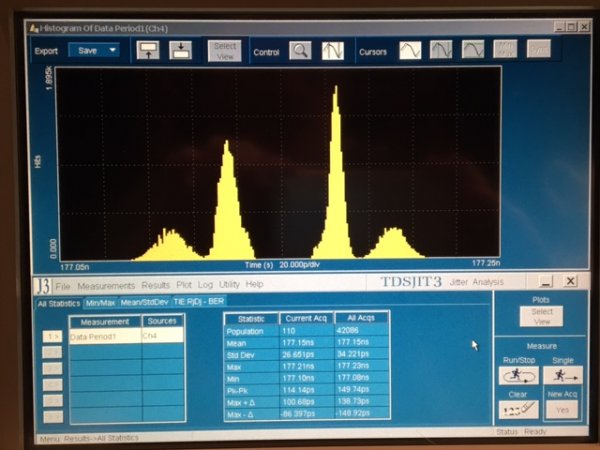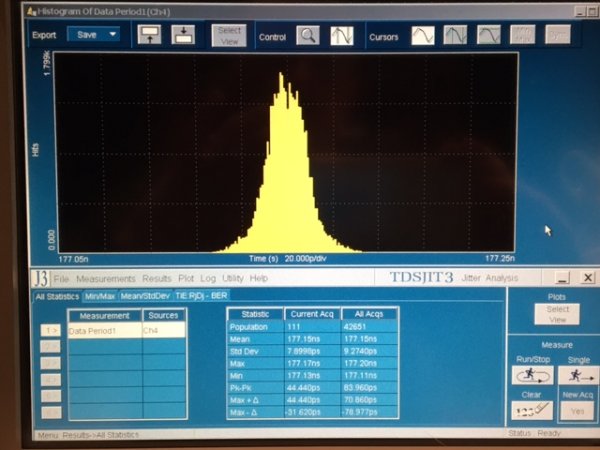I don't trust the current spectral jitter measurement techniques to tell me anything about the sound quality. There does not appear to be a correlation between jitter and SQ, except for maybe at a gross level ie; 100nsec jitter sounds worse than 10psec of jitter. I want to change this.
I have been using a direct real-time measurement method rather than spectral, I drive the S/PDIF signal to a 7GHz programmable scope with jitter measurement software on it that measures the variation in period of the waveform. This is showing real promise.
I have been able to capture the jitter of two very low jitter systems, my own Interchange Ethernet renderer and a Raspberry Pi HAT board with S/PDIF output. The HAT board claims to have 4-6psec of jitter and they publish the measurements. I will not divulge the manufacturer here.
The sound quality of the HAT board is very good, rendering detail similar to my own renderer at 1/20th of the cost, however there is a "hardness" to the sound and the deep image is a bit confused at times. To me, it is a bit stressful to listen using this HAT board. I am much more relaxed listening to my Interchange. I really expected that if the jitter was as low as advertised, that it would match or maybe even beat my Interchange.
Therefore, I used my measurement system to measure both to see if this difference in SQ might be detectable and maybe even predictable. The following plots are created by collecting thousands of period measurements on the fly while an entire track plays. The same track was played in complete for each Jitter measurement. The plots are histograms of the period. Both devices were driven from the same software and network, Jriver being the player. Both devices were powered the same way, both using the same LPS.
HAT board Jitter with 44.1 track:

Empirical Audio Interchange jitter with 44.1 track:

As you can see, both of these devices produce very low jitter, but the shape of the HAT board distribution might explain the different sonics.
This is an important observation because it is very possible that some devices with higher jitter may actually be more musical that some with lower jitter because of the difference in the jitter distribution. It is no longer I feel sufficient just to have low jitter. The distribution plot must be a single peak or closely spaced peaks with clean profile in order to achieve the best sonics.
Steve N.
Empirical Audio
I have been using a direct real-time measurement method rather than spectral, I drive the S/PDIF signal to a 7GHz programmable scope with jitter measurement software on it that measures the variation in period of the waveform. This is showing real promise.
I have been able to capture the jitter of two very low jitter systems, my own Interchange Ethernet renderer and a Raspberry Pi HAT board with S/PDIF output. The HAT board claims to have 4-6psec of jitter and they publish the measurements. I will not divulge the manufacturer here.
The sound quality of the HAT board is very good, rendering detail similar to my own renderer at 1/20th of the cost, however there is a "hardness" to the sound and the deep image is a bit confused at times. To me, it is a bit stressful to listen using this HAT board. I am much more relaxed listening to my Interchange. I really expected that if the jitter was as low as advertised, that it would match or maybe even beat my Interchange.
Therefore, I used my measurement system to measure both to see if this difference in SQ might be detectable and maybe even predictable. The following plots are created by collecting thousands of period measurements on the fly while an entire track plays. The same track was played in complete for each Jitter measurement. The plots are histograms of the period. Both devices were driven from the same software and network, Jriver being the player. Both devices were powered the same way, both using the same LPS.
HAT board Jitter with 44.1 track:

Empirical Audio Interchange jitter with 44.1 track:

As you can see, both of these devices produce very low jitter, but the shape of the HAT board distribution might explain the different sonics.
This is an important observation because it is very possible that some devices with higher jitter may actually be more musical that some with lower jitter because of the difference in the jitter distribution. It is no longer I feel sufficient just to have low jitter. The distribution plot must be a single peak or closely spaced peaks with clean profile in order to achieve the best sonics.
Steve N.
Empirical Audio

